JOAN MIRÓ (1893-1983)Tête et oiseau signed and numbered 'Miro 1/6' (to the right of the head) and inscribed with the foundry mark 'Paralleda' (to the right of the base) bronze on a wooden plinth 137.2cm (54in). high Conceived by 1975, this bronze version cast by the Fundició Parellada in 1981 in an edition of 9 numbered 0, 1/6-6/6, plus two nominative casts. FootnotesProvenance Private collection. Pierre Matisse Gallery, New York. Private collection, Europe (acquired from the above); their sale, Christie's, New York, 6 November 2007, lot 76. Private collection, Europe (acquired at the above sale). Literature Exh. cat., Miró: The Last Bronze Sculptures, 1981-83, New York, 1987, no. 3 (another cast illustrated on the cover). Exh. cat., Miró en las colecciones del Estado, Madrid, 1987, no. 99 (another cast illustrated p. 114). Exh. cat., Miró: Gemälde, Plastiken, Zeichnungen und Graphik: Werke aus den Kunstsammlungen des spanischen Staates, Frankfurt, 1988, no. 99 (another cast illustrated p. 130). Exh. cat., Miró: El sueño interrumpido, Paris, 1988, no. 35 (another cast illustrated). Exh. cat., Joan Miró a retrospective, London, 1999, no. 49 (another cast illustrated p. 71). Exh. cat., Miró: Mein Atelier ist mein Garten, Ludwigshafen, 2000, no. 70 (another cast illustrated p. 117). Exh. cat., Pierre Matisse and His Artists, New York, 2002 (another cast illustrated p. 292). E.F. Miró & P.O. Chapel, Joan Miró Sculptures. Catalogue raisonné, 1928-1982, Paris, 2006, no. 376 (another cast illustrated p. 349). I feel myself attracted by a magnetic force to an object, and then I feel myself being drawn towards another object which is added to the first, and their combination creates a poetic shock – which makes the poetry truly moving, and without which it would have no effect. - Joan Miró in a letter to Pierre Matisse, 1936. Stridently modern and relentlessly obscure, Joan Miró's Tête et oiseau generates shifting narratives of the ancient, the comical and the bizarre. This eerie symphony of morbidity and mythology meets its maker in the hands of Miró, a maestro in creating deeply personal and evocative assemblages. In his life-long dialogue of interventions with objects, Miró generated seismic shifts in the 20th Century conception of art. With its totemic gravitas and playful spontaneity, the present work forms a monument to the perpetuity of Surrealism, and of Miró's ever-lasting mark on this storied movement. Joan Miró spent a colourful childhood between Barcelona and the Catalan town of Mont-roig del Camp. His native region's festivals, architecture and art – particularly its vibrant Romanesque frescoes – were foundational to his early artistic style. Between 1912 and 1915 he studied at the progressive Escola d'Art Galí in Barcelona, wherein he was trained to intuit the life-force and substance of objects. In 1915 he struck out on his own, thence developing his iconic style – one rooted in fantasy, collage and organic forms. The Surrealists inducted Miró shortly after he moved to Paris in 1919, as he was attracted in turn to their edicts of spontaneity and metamorphosis. Ceramics and sculpture began to dominate Miró's artistic output at the end of the Second World War, during which he experimented with 'primitive' materials. In the 1950s, whilst collaborating with the ceramicist Josep Llorens i Artigas, Miró would incorporate fragments and off-cuts from the studio floor into his work. At that time, his close study of the prehistoric cave paintings in Altamira ignited his spiritual connection to bygone creators. In the 1960s, under the influence of his friend and dealer, Aimé Maeght, Miró's focus turned toward the natural environment. He began to assemble found objects and cast them in bronze. He paid close attention not only to their compositions but also to their patinas, which he considered to be of equal importance to the surfaces of his paintings. In this new poetic language, Miró's objects functioned as visual metaphors and
JOAN MIRÓ (1893-1983)Tête et oiseau signed and numbered 'Miro 1/6' (to the right of the head) and inscribed with the foundry mark 'Paralleda' (to the right of the base) bronze on a wooden plinth 137.2cm (54in). high Conceived by 1975, this bronze version cast by the Fundició Parellada in 1981 in an edition of 9 numbered 0, 1/6-6/6, plus two nominative casts. FootnotesProvenance Private collection. Pierre Matisse Gallery, New York. Private collection, Europe (acquired from the above); their sale, Christie's, New York, 6 November 2007, lot 76. Private collection, Europe (acquired at the above sale). Literature Exh. cat., Miró: The Last Bronze Sculptures, 1981-83, New York, 1987, no. 3 (another cast illustrated on the cover). Exh. cat., Miró en las colecciones del Estado, Madrid, 1987, no. 99 (another cast illustrated p. 114). Exh. cat., Miró: Gemälde, Plastiken, Zeichnungen und Graphik: Werke aus den Kunstsammlungen des spanischen Staates, Frankfurt, 1988, no. 99 (another cast illustrated p. 130). Exh. cat., Miró: El sueño interrumpido, Paris, 1988, no. 35 (another cast illustrated). Exh. cat., Joan Miró a retrospective, London, 1999, no. 49 (another cast illustrated p. 71). Exh. cat., Miró: Mein Atelier ist mein Garten, Ludwigshafen, 2000, no. 70 (another cast illustrated p. 117). Exh. cat., Pierre Matisse and His Artists, New York, 2002 (another cast illustrated p. 292). E.F. Miró & P.O. Chapel, Joan Miró Sculptures. Catalogue raisonné, 1928-1982, Paris, 2006, no. 376 (another cast illustrated p. 349). I feel myself attracted by a magnetic force to an object, and then I feel myself being drawn towards another object which is added to the first, and their combination creates a poetic shock – which makes the poetry truly moving, and without which it would have no effect. - Joan Miró in a letter to Pierre Matisse, 1936. Stridently modern and relentlessly obscure, Joan Miró's Tête et oiseau generates shifting narratives of the ancient, the comical and the bizarre. This eerie symphony of morbidity and mythology meets its maker in the hands of Miró, a maestro in creating deeply personal and evocative assemblages. In his life-long dialogue of interventions with objects, Miró generated seismic shifts in the 20th Century conception of art. With its totemic gravitas and playful spontaneity, the present work forms a monument to the perpetuity of Surrealism, and of Miró's ever-lasting mark on this storied movement. Joan Miró spent a colourful childhood between Barcelona and the Catalan town of Mont-roig del Camp. His native region's festivals, architecture and art – particularly its vibrant Romanesque frescoes – were foundational to his early artistic style. Between 1912 and 1915 he studied at the progressive Escola d'Art Galí in Barcelona, wherein he was trained to intuit the life-force and substance of objects. In 1915 he struck out on his own, thence developing his iconic style – one rooted in fantasy, collage and organic forms. The Surrealists inducted Miró shortly after he moved to Paris in 1919, as he was attracted in turn to their edicts of spontaneity and metamorphosis. Ceramics and sculpture began to dominate Miró's artistic output at the end of the Second World War, during which he experimented with 'primitive' materials. In the 1950s, whilst collaborating with the ceramicist Josep Llorens i Artigas, Miró would incorporate fragments and off-cuts from the studio floor into his work. At that time, his close study of the prehistoric cave paintings in Altamira ignited his spiritual connection to bygone creators. In the 1960s, under the influence of his friend and dealer, Aimé Maeght, Miró's focus turned toward the natural environment. He began to assemble found objects and cast them in bronze. He paid close attention not only to their compositions but also to their patinas, which he considered to be of equal importance to the surfaces of his paintings. In this new poetic language, Miró's objects functioned as visual metaphors and
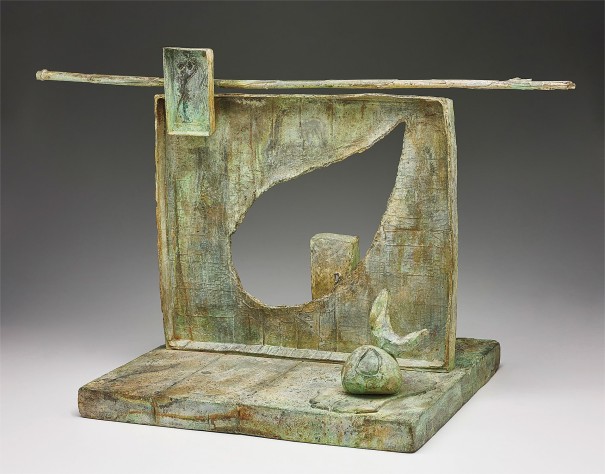
.jpg)
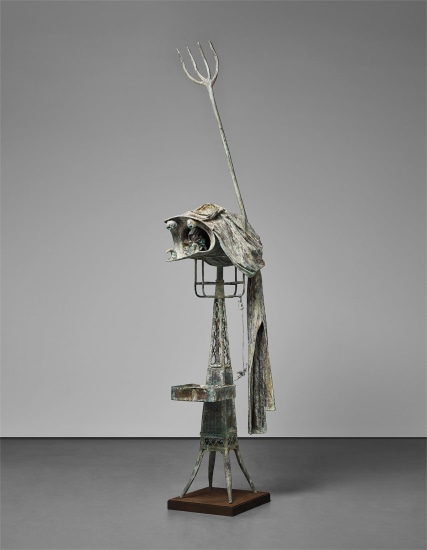
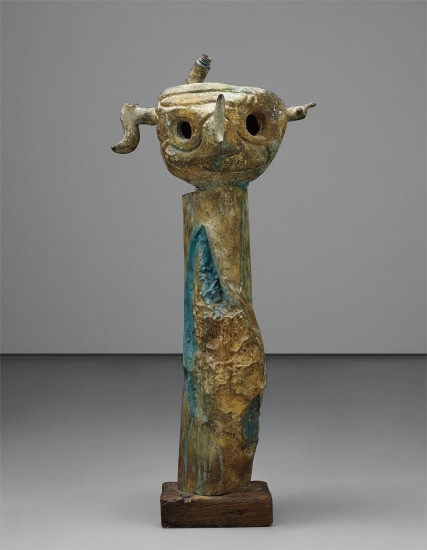
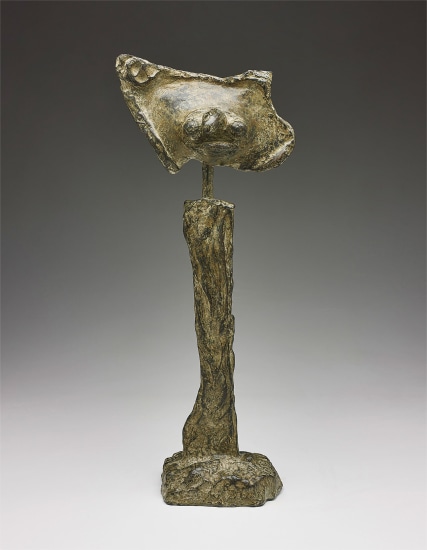




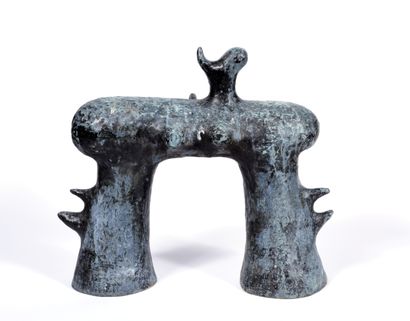



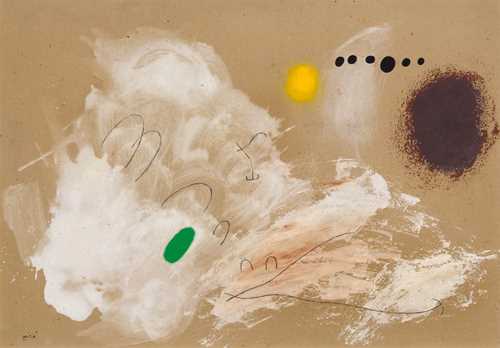

Try LotSearch and its premium features for 7 days - without any costs!
Be notified automatically about new items in upcoming auctions.
Create an alert